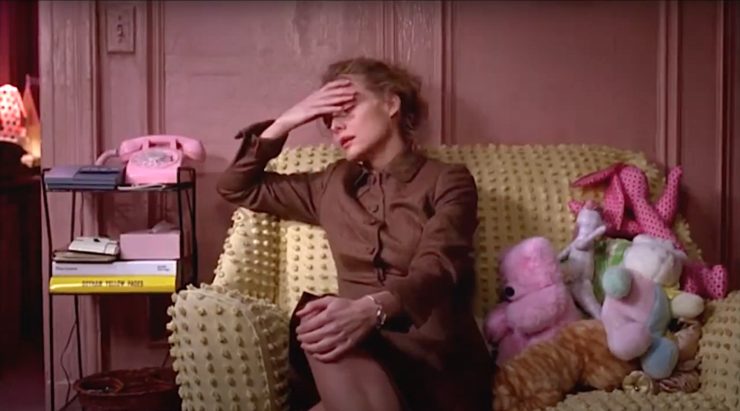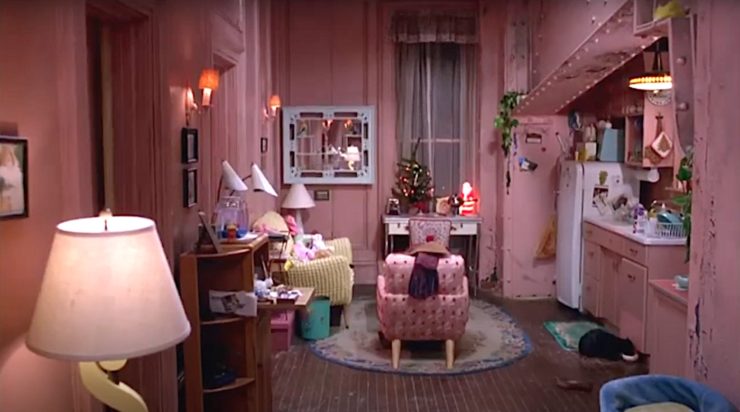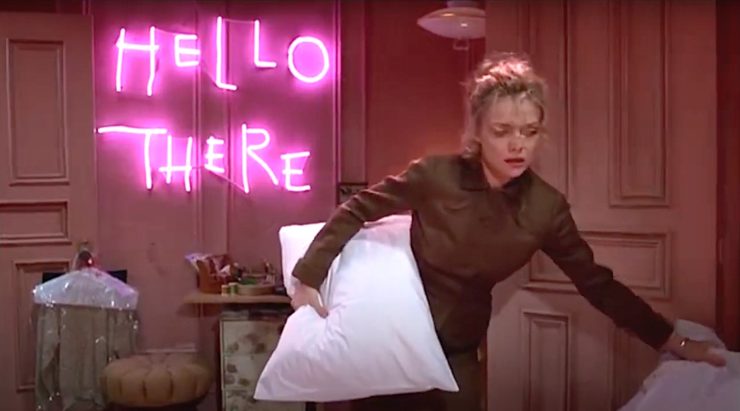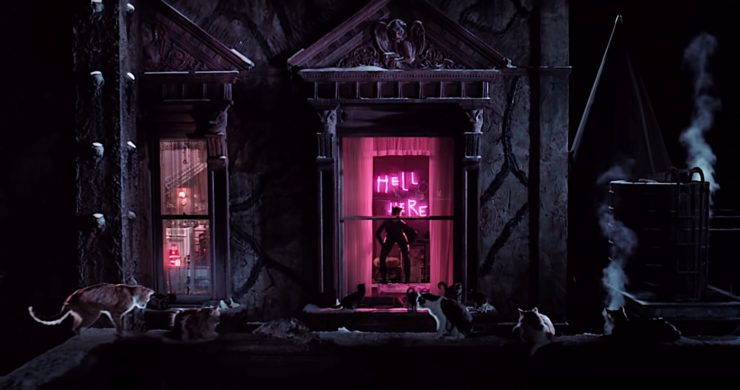Welcome to Close Reads! In this series, Leah Schnelbach and their guests dig into the tiny, weird moments of pop culture—from books to theme songs to viral internet hits—that have burrowed into our minds, found rent-stabilized apartments, started community gardens, and refused to be forced out by corporate interests. This time out, Leah Schnelbach meditates upon that most terrifying of topics…REAL ESTATE.
When you think of Batman Returns, what do you think of?
Catwoman deadpanning “Meow” as a building explodes behind her?
The Penguin eating raw fish in his campaign office?
The Penguin biting a staffer’s nose?
The Penguin commanding an army of militarized actual penguins?
OK, it turns out there was a lot of rad shit in that movie. But what I find myself thinking about most is Selina Kyle’s apartment.
The Gotham of the first Batman, designed by Anton Furst, is a hulking twilit nightmare of sweeping neo-gothic architecture. Humans are dwarfed by the buildings they live and work in, and Batman’s original cowl seems like it was designed to mimic the menace of the city skyline. The art museum is a cavernous converted train station. Joker works in an enormous dilapidated warehouse, and he dies at the foot of a crumbling grey clocktower. It’s always dark, even during the day. It’s always cold—I can’t imagine summer in Gotham.
In Batman Returns, Bo Welch transforms the city into a whimsical goth Christmas wonderland—but it’s still oversized, dark, and cold. Wayne Manor, the Cobblepot mansion, the Penguin’s attic lair, the sewer system—all huge, sprawling, mostly done in blacks and greys with the odd pop of white. Shreck’s offices are a bit more realistic, but they’re still stark spaces designed to make anyone who isn’t Max or Chip Shreck feel insignificant.
All of these spaces tell a story.
But there’s another story being told in the film, though we only get a few flashes of it, hear it briefly. The first time we come home with Selina, she’s just gotten through a terrible day at work (Max Shreck tells his colleagues “We haven’t fully housebroken Miss Kyle yet. But she does make a mean cup of coffee.”), been attacked in the street by a thug with a taser, and been summarily rescued by Batman, who didn’t even wait for her to thank him before sweeping away to more important business.

When she walks in her front door she says: “Hi honey, I’m home!” before following it up with “Oh, I forgot, I’m not married.” Her delivery on this line is flat and rote; clearly she says this to herself, or her cat, or her empty apartment every day. She hits play on her answering machine (younger readers: this was like a voicemail that you were actually expected to listen and respond to before texting was invented. Barbaric practice.) The first message is her mom:
“It’s your mother, just calling to say hello…”
“Yeah, right…but?”
“...but I’m disappointed you’re not coming home for Christmas. I don’t understand why you insist on languishing in Gotham City as some kind of lowly secretary.”
“Lowly assistant.”
Her boyfriend dumps her, a robotic voice recites an ad for Gotham Lady perfume, her own voice reminds her of another assignment for Shreck. The messages, her drab brown skirt suit, her jokes about her cat’s active sex life—all of them tell us a story of Selina Kyle, the invisible mouse who keeps her head down and her mouth shut to cope with a life that does not make her happy.
But as the camera swings around we see a different story.

First of all, the walls are pink. Not just an accent wall, or one room’s walls, but every wall, and all the cabinets. The floor is basic dark hardwood, but Selina’s covered it with bright rugs. She doesn’t have a couch, a TV, or a dining table, but she has a small yellow loveseat and a pink chair. Selina has very little space. This room is a living room and kitchen smooshed together; the other room has a Murphy bed folded into the wall and enough space for a dresser and sewing table. One door reveals a closet, presumably the other one is a bathroom. That’s it: three rooms and a closet for the main assistant to a man who rivals Bruce Wayne as a power broker of Gotham.

If you listen to her answering machine you’ll get the picture of a lonely desperate secretary flailing in the big city. But if you look at what she’s done with three rooms. The riot of color, the neon sign singing Hello There in yet another shade of pink, the bits of fabric thrown over lamps to tint the light. The way she chose to structure her living space around the potential for conversation rather than watching TV. The way she set a desk up with a view of her city. Selina-before-Catwoman has created exactly the apartment that a crafty teenage girl would dream up while living with the overbearing mother we hear on Selina’s answering machine.
Selina almost certainly re-upholstered the furniture. Can you imagine walking into a thrift shop in Gotham and finding a retro canary yellow chair that was actually in decent shape? That hadn’t been pre-owned by The Riddler, or had one of The Joker’s victims tied to it? She carried the pink theme through for the chair, used the yellow for the loveseat. She probably made all of her curtains, too. The tea rose pattern on her kitchen curtains echoes the floral sheets we see when she unfolds her Murphy bed. Did she paint the writing desk herself? Pick out dishes in pink and yellow, too, to complement the whole place?
Given her mother’s message we know she moved to Gotham from somewhere else. I think it’s safe to assume somewhere smaller—if home was just over the river in Metropolis, a trip home wouldn’t be a big deal, and her mother probably wouldn’t sound so disapproving of Selina’s life in the big city. Selina’s choosing to stay here, in this tiny, crappy apartment, because she wants to Make It, right? She doesn’t want to be Shreck’s assistant forever. And she may have decided to stay in Gotham for the holiday in case the trip with the now-ex-bf materialized, but she also took the time to set up tiny Christmas tree and a retro light-up Santa.
I keep coming back to the sign. Hello There, in buzzing pink neon, in her bedroom. A bold statement to anyone she brings home with her, and purposely framed in one of her windows. The thing is, neon signs are expensive. Her apartment, clearly, is not. When she opens her closet we see that her non-work clothes are mostly just t-shirts and regular dresses, nothing too fancy, and, again, she’s probably sewn and painted everything with character in her home. That sign is an extravagance. A splurge. A birthday present, carefully packed and moved? Or, I would bet, her One Big Purchase after she moved into this place. A thing she did for herself, because she wanted to be the kind of person who would own such a thing.
Her mom’s voice in the machine? That does not sound like a person who would let her kid hang a buzzing neon sign in her room.
The thing I keep coming back to, and the reason I wanted to write some of my thoughts, is this: it didn’t have to be like this. In Batman, Vicki Vale’s apartment is nice—spacious, tasteful, minimalist, an utterly bland landscape of beiges and creams, meaningless vases and silver platters on the mantelpiece. (Which, why? I mean, lucky for Bruce Wayne but also why is that there???) But there isn’t even a hint of the woman who would move to Gotham City because she became obsessed with the idea of a man dressing as a bat to fight crime. Bruce’s home is giant and chilly. He doesn’t even look comfortable sitting in front of his own fire. But other than some odd bits of armor and medieval torture devices he doesn’t bother to personalize it, even though he has more than enough money. At least in Burton’s two films, while we see rooms that feel like Batman and one that feels like Alfred, we never see even a corner of Wayne Manor that feels like Bruce.
But Selina’s place is TACKY. It’s garish and bright and absurd. In this city of sleek black towers she’s carved out a tiny haven that is utterly hers. In a city overrun with crime and literal supervillains she leaves a window open so her cat can come and go. In a city where she’s been treated like garbage, she keeps her neon sign lit, and turned her tiny living room into a place where she and her friends can talk to each other, face to face.
Leah Schnelbach needs a neon sign. Come talk to them in the cramped, overstuffed living room that is Twitter!










